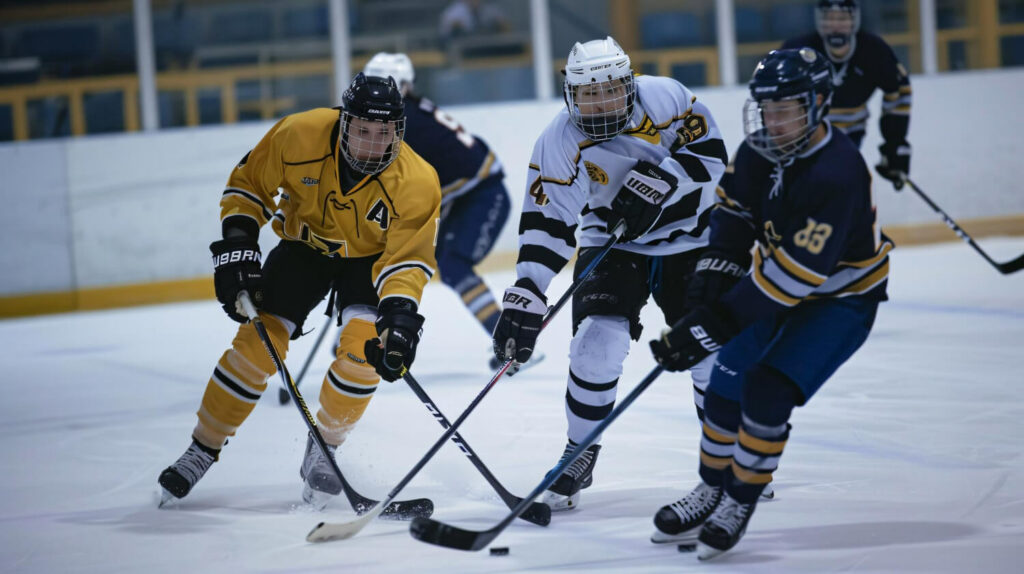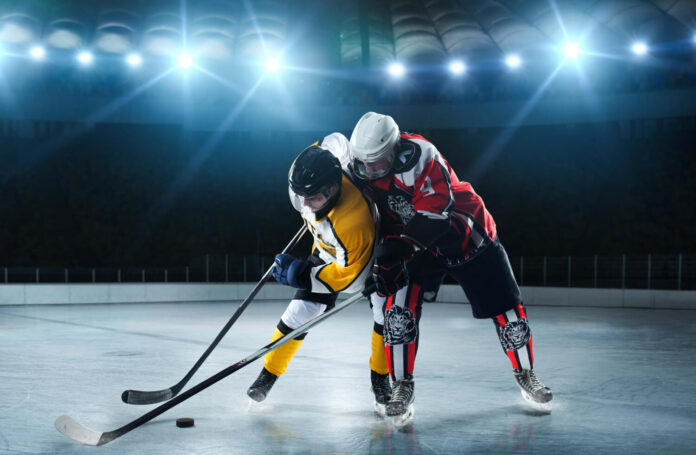In a standard game of ice hockey, there are three periods. Each period lasts for 20 minutes of playtime.
The game is divided this way to ensure players have enough rest and to keep the action at a high level throughout the match. These periods are separated by intermissions, which usually last for about 15 minutes.
Now we know how many periods in hockey there are, but how long do they last and what happens during the intermissions? Let’s find out.
Why Three Periods?
The three-period format wasn’t always the standard in hockey. In the early days of the sport, the game was divided into two halves. However, this setup was changed to three periods for several reasons:
- Player Fatigue: Playing two long halves made players extremely tired. By splitting the game into three periods, players have more opportunities to rest and recover, ensuring a higher quality of play.
- Ice Maintenance: Ice conditions can deteriorate quickly with constant play. The intermissions between periods give the arena staff time to resurface the ice, providing a better playing surface for the players.
- Strategic Breaks: Coaches use the breaks between periods to adjust their strategies and talk to their players. This can make the game more dynamic and interesting.
What Happens During Intermissions?
Intermissions are not just breaks for the players; they also offer a chance for the fans to grab snacks, stretch their legs, and discuss the game so far. Here’s what typically happens during these breaks:
- Ice Resurfacing: The Zamboni, a machine that smooths out the ice, comes out to ensure the playing surface is in top condition.
- Team Strategy: Coaches discuss tactics and make adjustments based on the performance in the previous period.
- Fan Engagement: Many arenas have entertainment activities for fans, such as contests, music, and videos.
Overtime and Shootouts: Extending the Game
Sometimes, a hockey game doesn’t end after the three regular periods. If the score is tied at the end of the third period, the game goes into overtime. Here’s how it works:
- Regular Season Overtime: In regular season NHL games, overtime is a sudden-death period lasting five minutes. Teams play with fewer skaters (3-on-3), which usually leads to quick and exciting plays. If no one scores during this time, the game goes to a shootout.
- Shootout: In a shootout, each team selects three players to take penalty shots against the opposing goalie. If the game is still tied after these three rounds, the shootout continues with one player from each team until there’s a winner.
- Playoff Overtime: In playoff games, overtime periods are different. Instead of a five-minute sudden-death period, teams play 20-minute periods until someone scores. There are no shootouts in the playoffs; the game continues with full periods until a team wins.
History of Periods in Hockey
To truly appreciate why hockey is played in three periods, it’s helpful to look back at the history of the sport. Learning about the evolution of the game’s structure sheds light on how we arrived at the current format.

Early Days: Two Halves
In the earliest days of hockey, the game was played in two halves. This was similar to other sports like soccer, where the match was divided into two large sections of continuous play. However, this format had its drawbacks:
- Player Exhaustion: Players found it difficult to maintain a high level of performance throughout the two long halves. Fatigue set in, which often led to a decrease in the quality of play and an increase in injuries.
- Ice Quality: The ice surface would deteriorate significantly over the course of each half. This made the puck more difficult to control and could potentially lead to more injuries.
The Shift to Three Periods
Recognizing these issues, the hockey authorities decided to experiment with different formats. By the early 20th century, the three-period format was adopted. Here’s why this change was so beneficial:
- Improved Player Performance: By splitting the game into three 20-minute periods, players had more opportunities to rest. This helped maintain a high intensity of play throughout the game.
- Better Ice Maintenance: The intermissions allowed the ice to be resurfaced twice during the game, ensuring better conditions for the players.
- Enhanced Spectator Experience: With more breaks, fans had more opportunities to engage with the game, grab refreshments, and enjoy additional entertainment.
Official Adoption
The National Hockey League (NHL), which was established in 1917, officially adopted the three-period format. This change was soon followed by other leagues around the world. The new structure became the standard, and it’s still in use today.
Evolution of Intermissions
Intermissions have also evolved over time. Initially, they were simple breaks for players to rest. However, as the sport grew in popularity, intermissions became a key part of the entertainment experience:
- Fan Engagement: Modern arenas use intermissions to engage fans with various activities. There might be on-ice contests, performances, or videos that highlight interesting aspects of the game.
- Commercial Opportunities: For broadcasters, intermissions provide an opportunity to run commercials, which is crucial for the business side of the sport.
- Analysis and Replays: Fans get to see replays of key moments and hear expert analysis during intermissions. This helps them understand the finer points of the game and stay engaged.
International Variations
While the three-period format is standard in the NHL, international hockey and other leagues sometimes have variations. For instance:
- European Leagues: Most European leagues also follow the three-period format, but some minor leagues might have different structures.
- Olympic Hockey: Olympic hockey games also consist of three periods, adhering to the international standards set by the International Ice Hockey Federation (IIHF).
Rules Governing the Periods in Hockey
Understanding the rules that govern the periods in hockey is crucial for appreciating the game’s structure and flow.
Timing of the Periods
In standard ice hockey, each game consists of three periods, each lasting 20 minutes. Here’s a breakdown of how the timing works:
- Regular Play: Each period is 20 minutes long. The clock stops whenever there is a stoppage in play, such as for goals, penalties, or when the puck goes out of bounds. This ensures that the full 20 minutes of playtime is used effectively.
- Intermissions: After the first and second periods, there are intermissions, typically lasting 15 to 20 minutes. During this time, the ice is resurfaced, and players rest and regroup.
Penalties and Their Impact on Play
Penalties play a significant role in hockey, affecting how the game is played during each period. Here’s how penalties are structured:
- Minor Penalties: These are the most common and last for two minutes. Examples include tripping, hooking, and slashing. The penalized player sits in the penalty box, and their team plays shorthanded (with one fewer player on the ice) for the duration of the penalty.
- Major Penalties: These last for five minutes and are given for more serious infractions, such as fighting. During a major penalty, the penalized player’s team plays shorthanded for the entire five minutes.
- Misconduct Penalties: These are 10-minute penalties and are typically given for unsportsmanlike conduct. The penalized player must sit out for 10 minutes, but their team doesn’t play shorthanded.
- Double Minor Penalties: These last for four minutes and are often given for infractions like high-sticking that draw blood.
Power Plays and Penalty Killing
When a team is penalized, the opposing team goes on a “power play.” This means they have a numerical advantage, making it easier to score. Conversely, the penalized team is “killing” the penalty, trying to prevent the opposing team from scoring.
- Power Play Strategy: Teams on a power play often use a setup called the “umbrella” or “diamond” to maximize their scoring chances.
- Penalty Killing Strategy: Teams killing a penalty focus on defensive formations, such as the “box” or “diamond,” to block shots and clear the puck from their zone.
Overtime
If the score is tied at the end of the third period, the game goes into overtime. The rules for overtime vary depending on the context of the game.
Regular Season Overtime
- Sudden-Death Overtime: This period lasts five minutes, and the first team to score wins the game. Teams play with fewer skaters (3-on-3), leading to more open ice and scoring opportunities.
- Shootout: If no team scores during the overtime period, the game goes to a shootout. Each team selects three players to take penalty shots. If still tied, the shootout continues with one player from each team until a winner is decided.
Playoff Overtime
- Extended Overtime Periods: In playoff games, overtime periods are 20 minutes each, and teams play 5-on-5. The game continues until a team scores, with no shootouts.
- Endurance and Strategy: Playoff overtime can extend well beyond one extra period, requiring teams to maintain high levels of endurance and strategic play.
Timeouts and Video Reviews
Teams have one 30-second timeout that they can use at any point during regulation time or overtime.
Additionally, coaches can challenge certain plays, such as offside calls or goalie interference, using video review. The use of technology ensures that critical decisions are made accurately.
Fascinating Facts About Hockey Periods
Hockey is filled with history and unique moments, especially when it comes to the periods of play.

Record-Breaking Moments
Hockey has seen some incredible performances and record-breaking moments during its three periods. Here are a few highlights:
- Fastest Goals: One of the most impressive feats in hockey is scoring a goal quickly after the start of a period. The fastest goal in NHL history was scored just three seconds into the game by Doug Smail of the Winnipeg Jets in 1981.
- Most Goals in a Period: The NHL record for the most goals scored by a team in a single period is nine. This record is held by the Buffalo Sabres, who accomplished this against the Toronto Maple Leafs on March 19, 1981.
- Most Points in a Period: The most points scored by a player in one period is six. This record is held by Bryan Trottier of the New York Islanders, who achieved it on December 23, 1978.
Unique Occurrences
Hockey’s three-period format has led to some unique and memorable moments in the sport’s history:
- Lengthy Overtime Periods: In playoff hockey, overtime can extend well beyond the regular periods. One of the longest NHL playoff games took place on March 24, 1936, when the Detroit Red Wings and the Montreal Maroons played six overtime periods before Detroit finally scored the winning goal after 116 minutes and 30 seconds of extra play.
- Unusual Delays: Sometimes, unexpected events can delay the game between periods. For example, equipment malfunctions like broken Zambonis, power outages in the arena, or even unplanned events like a fan proposal on the ice can cause delays.
- Historic Firsts: The first televised NHL game, which took place on October 11, 1952, between the Montreal Canadiens and the Detroit Red Wings, featured the now-standard three-period format. This broadcast helped popularize hockey and brought the excitement of all three periods into homes across North America.
Memorable Games
Some games are remembered for the incredible drama and excitement that unfolded during their three periods:
- The “Miracle on Ice”: During the 1980 Winter Olympics, the USA hockey team defeated the heavily favored Soviet Union in a game that has become legendary. The three periods of this game were filled with intense action and remarkable goaltending by Jim Craig, leading to an unforgettable 4-3 victory for Team USA.
- Stanley Cup Finals: Many Stanley Cup Finals games have had thrilling third periods where the outcome of the game, and the championship, hung in the balance. One memorable example is Game 7 of the 2019 Stanley Cup Finals, where the St. Louis Blues won their first-ever championship with a decisive third-period performance.
Trivia and Fun Facts
- Overtime Dynamics: In the regular season, the shift to 3-on-3 overtime has dramatically increased the number of games that end before reaching a shootout, making overtime periods especially thrilling for fans.
- Period Nicknames: The three periods are sometimes humorously referred to as “three acts” in the “drama” of hockey, with each period bringing its own tension and excitement.
- Historical Changes: The introduction of the three-period format and the subsequent changes in rules over the years, like the addition of video review and coach’s challenges, have continually evolved to make each period more engaging and fair.
Frequently Asked Questions
How Many Periods in Hockey?
A standard hockey game consists of three periods. Each period lasts for 20 minutes of playtime. This format is used in the NHL and most other professional and amateur hockey leagues around the world.
Why Are There Three Periods in Hockey?
The three-period format was adopted to improve player performance and ice quality. Originally, hockey games were played in two halves, but this led to significant player fatigue and deteriorating ice conditions.
Splitting the game into three periods allows for more frequent breaks, helping players rest and recover, and provides opportunities for the ice to be resurfaced.
What Happens During Intermissions?
Intermissions occur between each of the three periods and typically last for 15 to 20 minutes. During this time, the ice is resurfaced by a Zamboni to ensure optimal playing conditions.
Players use the break to rest and discuss strategies with their coaches. For fans, intermissions offer a chance to grab refreshments and enjoy arena entertainment.
How Does Overtime Work in Hockey?
If the score is tied at the end of the third period, the game goes into overtime. The rules for overtime vary:
- Regular Season: Overtime is a five-minute sudden-death period with teams playing 3-on-3. If no goal is scored, the game proceeds to a shootout.
- Playoffs: In playoff games, overtime periods last 20 minutes, and teams play 5-on-5. The game continues with additional overtime periods until a team scores.
What Is a Power Play?
A power play occurs when one team has a numerical advantage on the ice due to an opposing player’s penalty. This situation usually lasts for two minutes (minor penalty) or five minutes (major penalty). During a power play, the penalized team plays with fewer players, giving the other team a better chance to score.
Can a Game End in a Tie?
In the NHL, games cannot end in a tie. If the score is tied after regulation time (three periods), the game proceeds to overtime and, if necessary, a shootout to determine the winner. However, some amateur and youth leagues may still allow games to end in a tie.
What Are the Breaks Between Periods Called?
The breaks between periods are called intermissions. They are crucial for maintaining the quality of play, as they allow time for the ice to be resurfaced and for players to rest and regroup.
How Long Is Each Period in Hockey?
Each period in a standard hockey game lasts for 20 minutes of playtime. The clock stops for stoppages in play, ensuring that each period contains a full 20 minutes of action.
What Is the Purpose of the Zamboni?
The Zamboni is a machine used to resurface the ice during intermissions. It smooths out the ice, filling in grooves and making the surface optimal for play. This is crucial for maintaining good playing conditions and reducing the risk of injuries.




